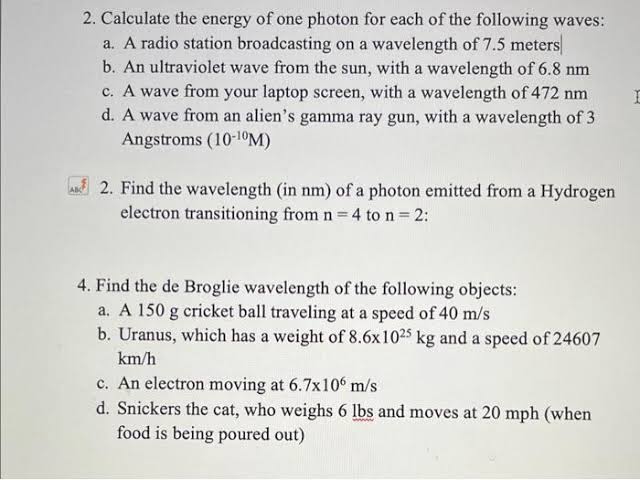1. Calculate the energy of one photon for the following waves: a. A radio station broadcasting on a wavelength of 7.5 meters. b. An ultraviolet wave from the sun, with a wavelength... 1. Calculate the energy of one photon for the following waves: a. A radio station broadcasting on a wavelength of 7.5 meters. b. An ultraviolet wave from the sun, with a wavelength of 6.8 nm. c. A wave from your laptop screen, with a wavelength of 472 nm. d. A wave from an alien's gamma ray gun, with a wavelength of 3 Angstroms (10^-10 M). 2. Find the wavelength (in nm) of a photon emitted from a Hydrogen electron transitioning from n = 4 to n = 2. 3. Find the de Broglie wavelength of the following objects: a. A 150 g cricket ball traveling at a speed of 40 m/s. b. Uranus, which has a weight of 8.6x10^25 kg and a speed of 24607 km/h. c. An electron moving at 6.7x10^6 m/s. d. Snickers the cat, who weighs 6 lbs and moves at 20 mph (when food is being poured out).

Understand the Problem
The question requires the calculation of the energy of photons for various wavelengths and finding wavelengths and de Broglie wavelengths for different objects and scenarios. It involves using formulas related to photon energy and de Broglie wavelength.
Answer
Answer for screen readers
Steps to Solve
- Calculate Photon Energy for Different Wavelengths
To find the energy $E$ of a photon, we can use the formula:
$$ E = \frac{hc}{\lambda} $$
where:
- $h$ is Planck's constant ($6.626 \times 10^{-34} \text{ J s}$)
- $c$ is the speed of light ($3.00 \times 10^8 \text{ m/s}$)
- $\lambda$ is the wavelength (in meters)
a. For 7.5 m:
Convert the wavelength to meters (already in meters).
$$ E = \frac{(6.626 \times 10^{-34})(3.00 \times 10^8)}{7.5} $$
b. For 6.8 nm:
Convert 6.8 nm to meters:
$$ 6.8 \text{ nm} = 6.8 \times 10^{-9} \text{ m} $$
Then,
$$ E = \frac{(6.626 \times 10^{-34})(3.00 \times 10^8)}{6.8 \times 10^{-9}} $$
c. For 472 nm:
Convert 472 nm to meters:
$$ 472 \text{ nm} = 472 \times 10^{-9} \text{ m} $$
Then,
$$ E = \frac{(6.626 \times 10^{-34})(3.00 \times 10^8)}{472 \times 10^{-9}} $$
d. For 3 Angstroms:
Convert 3 Angstroms to meters:
$$ 3 \text{ Angstroms} = 3 \times 10^{-10} \text{ m} $$
Then,
$$ E = \frac{(6.626 \times 10^{-34})(3.00 \times 10^8)}{3 \times 10^{-10}} $$
- Find the Wavelength of the Hydrogen Photon Transition
For an electron transitioning from $n=4$ to $n=2$, use the Rydberg formula:
$$ \frac{1}{\lambda} = R_H \left( \frac{1}{n_1^2} - \frac{1}{n_2^2} \right) $$
where $R_H \approx 1.097 \times 10^7 \text{ m}^{-1}$, $n_1 = 2$, and $n_2 = 4$.
Calculate:
$$ \frac{1}{\lambda} = 1.097 \times 10^7 \left( \frac{1}{2^2} - \frac{1}{4^2} \right) $$
- Calculate De Broglie Wavelengths
The de Broglie wavelength $\lambda_{dB}$ is given by:
$$ \lambda_{dB} = \frac{h}{mv} $$
where:
- $m$ is the mass (in kg)
- $v$ is the velocity (in m/s)
a. For Cricket Ball:
Convert mass to kg:
$$ 150 \text{ g} = 0.15 \text{ kg} $$
Calculate:
$$ \lambda_{dB} = \frac{(6.626 \times 10^{-34})}{(0.15)(40)} $$
b. For Uranus:
Mass is $8.6 \times 10^{25}$ kg, speed is $24607 \text{ km/h}$. Convert speed:
$$ 24607 \text{ km/h} = \frac{24607 \times 1000}{3600} \text{ m/s} $$
Calculate:
$$ \lambda_{dB} = \frac{(6.626 \times 10^{-34})}{(8.6 \times 10^{25})(v)} $$
c. For Electron:
With $v = 6.7 \times 10^6 \text{ m/s}$ and mass $m \approx 9.11 \times 10^{-31} \text{ kg}$:
$$ \lambda_{dB} = \frac{(6.626 \times 10^{-34})}{(9.11 \times 10^{-31})(6.7 \times 10^6)} $$
d. For Snickers the Cat:
Convert weight to mass (6 lbs = 2.72 kg) and speed (20 mph to m/s):
$$ 20 \text{ mph} = \frac{20 \times 1609.34}{
AI-generated content may contain errors. Please verify critical information